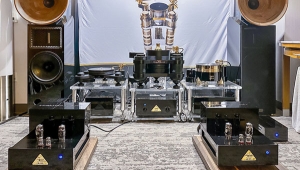| Columns Retired Columns & Blogs |
Acoustic Energy Aegis One loudspeaker
In this issue's "Letters" column, you will find comments from readers who are bothered by what they perceive to be this magazine's emphasis on reviewing very expensive technology. Yes, we do cover a lot of cutting-edge technology, and it is, of necessity, expensive. But our experience has been that that technology invariably trickles down to products that real people can actually afford.
Footnote 1: I reviewed the AE1 in the September 1988 Stereophile (Vol.11 No.9), with a Follow-Up in July 1992 (Vol.15 No.7).
 A case in point is the Aegis One, from Acoustic Energy. This British company made its name in the late 1980s with an impressive and expensive minimonitor, the AE1. For a long time, the AE1—with its wide dynamic range, grain-free midrange, and superb soundstaging—was my standard recommendation for people with deep pockets but small rooms (footnote 1).
A case in point is the Aegis One, from Acoustic Energy. This British company made its name in the late 1980s with an impressive and expensive minimonitor, the AE1. For a long time, the AE1—with its wide dynamic range, grain-free midrange, and superb soundstaging—was my standard recommendation for people with deep pockets but small rooms (footnote 1).
Acoustic Energy has now introduced the Aegis One; its price is one tenth that of the AE1 in its current, Signature guise. Does the Aegis One live up to what its heritage promises? I asked the company's US distributor, Audiophile Systems, to send me a pair so I could find out.
Aegis
Named after the mythical shield of Zeus, the Aegis One combines the popular 1" silk-dome tweeter from VIFA with a 5" alloy-cone woofer, these mounted vertically in-line on the speaker's black-painted front baffle. Whereas the AE1 woofer's metal cone is spun, allowing its thickness to vary across its diameter, the Aegis' is pressed from alloy sheet, which keeps costs down. The cone surround appears to be made from foam, which I initially found alarming, given the condition of the foam surrounds of the woofers of the early-'80s-vintage Boston A40s that, until recently, graced my mother-in-law's system. However, Acoustic Energy points out that the Aegis One's surrounds are made with a high proportion of rubber, which is not affected by the ultraviolet radiation that used to destroy surrounds of pure polyurethane foam.
A good touch at this price point is that both drive-units' chassis are rabbeted into the panel. The woofer is reflex-loaded with a flared 2"-diameter port on the rear panel, placed above a pair of five-way binding posts. The crossover comprises three plastic-film capacitors, three resistors, and two inductors (one air-cored, one ferrite-cored), mounted on a small printed-circuit board attached to the inside of the terminal panel. Internal connection to the drive-units consists of reasonably large-gauge, OFC copper wire.
At 14.5" high, the Aegis' cabinet is larger than the AE1's, and is constructed of 15mm MDF stiffened by a vertical H-brace, and with a 25mm baffle. To provide a modicum of damping, a wad of acrylic fiber is suspended in the center of the enclosure, where the air velocity is highest. The black-cloth grilles are stretched over lightweight polystyrene frames, these profiled to minimize the acoustic obstruction they would otherwise present to the drive-units.
Other than its vinyl finish, there is little in the Aegis One's design or construction to hint at its low price. But the manufacturing costs have been kept down by Acoustic Energy having the speaker assembled in Malaysia. (AE-series speakers are still made in England.)
Footnote 1: I reviewed the AE1 in the September 1988 Stereophile (Vol.11 No.9), with a Follow-Up in July 1992 (Vol.15 No.7).
- Log in or register to post comments




































